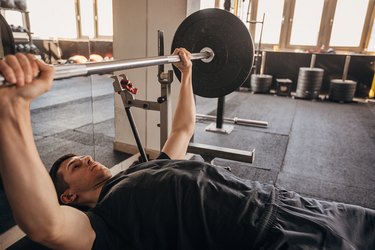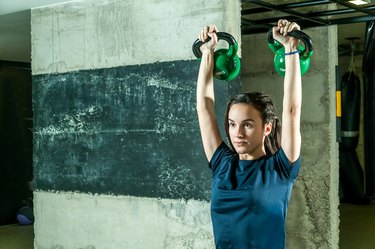

Skull crushers may sound like a fast-track to the emergency room, but they're actually one of the best triceps exercises for building arm strength and definition.
- What is a skull crusher? It's an arm exercise that involves lying down on your back and lowering weights toward your head by bending your elbows. You can do it with dumbbells, barbells or resistance bands.
- What are the main skull crusher muscles worked? As an isolation exercise, it targets your triceps — the muscle group in the back of your upper arms. It also works your core, forearms, grip and the stabilizing muscles in your shoulders.
- What's the difference between it and a lying triceps extension? While there's widespread "lying triceps extension vs. skull crusher" confusion, the lying triceps extension is simply the more technical term for the movement.
- Who can do skull crushers? Most people who are comfortable bringing weight overhead can do this exercise. Anyone with elbow injuries should avoid the movement until cleared by their physical therapist.
Video of the Day
How to Do Skull Crushers With Perfect Form
Dumbbell Skull Crusher
- Lie on a weight bench with your back flat against it. Hold a dumbbell in each hand, shoulder-width apart, palms facing inwards.
- Straighten both arms so the weights are at eye level and brace your core.
- Keeping your elbows tight, lower both dumbbells as far as comfortable.
- Once you feel a squeeze in your triceps, pause, then extend your elbows to raise the weights back to the starting position.
Tip
If you don't have a weight bench or simply don't want to do skull crushers on a bench, you can do them lying on the floor.
Watch the Full Tutorial
5 Tips for Better Lying Triceps Extensions
1. Squeeze Your Triceps
"The key thing to remember is that this is a triceps movement and not a back and shoulder movement," says Brett Durney, DPT, CPT, a physical therapist and co-founder of Fitness Lab.
Rather than employing a dumbbell pull-over motion, which shifts the work from your triceps to your lats, make sure your triceps are doing the work.
Think about pressing your upper back into the bench while you work, he suggests. As you lower the weight down, you should feel a stretch in your triceps. Then, concentrate of squeezing your triceps as you bring the weight back up over your shoulders.
2. Go Light
You don't need a lot of resistance to work your triceps with this move. And because it's an isolation exercises, it's generally best to use light weights and higher rep counts, explains Sam Becourtney, DPT, CSCS, a physical therapist and strength coach at Bespoke Treatments in New York City.
Once doing 3 to 4 sets of 10 to 12 reps feels easy, try progressing the weight.
Also keep in mind that the equipment you use will affect how much weight you can move. Pound per pound, EZ bar and barbell triceps extensions are actually easier than skull crushers with dumbbells. That's because dumbbells load each arm separately, meaning your triceps and shoulders have to work overtime to stabilize the weights, Durney says.
3. Slow Things Down
To make your triceps really work for you, focus on moving as slowly as possible, explains certified strength and conditioning specialist Jake Harcoff, MS, CSCS.
This increases the amount of time your muscles are under tension and the amount of (good) muscle damage you do during your sets. "Try doing super slow reps," he says. Think: 5 seconds down, 5 seconds up.
Alternatively, you can drawing out only the eccentric — or lowering — phase of the movement. Doing so can help you build more muscle.
4. Keep Your Elbows Tucked
To truly isolate your triceps and make them take the brunt of the load, your set-up is key. Whether you're doing this move on a bench or on the floor, it's important to keep your elbows tucked — remember, your hands should never be greater than shoulder-width apart — as you lower and lift the weight.
By slowing down the movement with the last tip, you also have more control in keeping your elbows in and avoid flaring them out.
5. It's OK to Let Your Upper Arms Tilt Backward
It used to be that coaches said your upper arms should stay perfectly vertical during each rep. No more.
"By incorporating a slight reach overhead — starting with the weights a bit further 'backward' over your forehead— you will really nail the long head, which is the commonly neglected part of the triceps," Becourtney says.
For a focus on the long head of your triceps (the largest segment, which we'll explain more next), try lowering the weights toward the top of your head, or even slightly behind it.
Related Reading
4 Skull Crusher Benefits
1. Stronger Triceps
Lying triceps extensions work all three sections (aka heads) of your triceps — the medial, lateral and long head — for superior muscle and strength benefits, Becourtney says.
The medial head is the deepest of the three, with the lateral and long heads mostly covering it from view. The lateral head is the most visible, with its horseshoe shape. Meanwhile, the long head is the largest of the three.
The lying dumbbell triceps extension shines for its ability to work the long head, which many other triceps moves miss. That's because the long head connects to your shoulder, so the overhead positioning works the long head harder than elbows-at-your-sides exercises like triceps push-downs, he explains.
2. Improved Posture
"Having strong triceps is fundamental for good posture," Harcoff says. Because your triceps can help pull your shoulders back, they prevent them from falling forward into a slouched position.
"This is super important for anyone who spends a lot of time at a desk throughout the day," he says.
3. Better Performance
Your triceps help you execute both pushing and pulling movements, he says. "That means that they play an important role in generating any kind of strength with the upper body."
For anyone playing a sport that involves upper-body strength, such as softball, tennis, squash or rugby, this means doing lying triceps extensions can help you win games, matches and more.
The exercise can be particularly beneficial in improving your bench press, clean, jerk and snatch, Durney says.
4. Healthier Elbows and Shoulders
The triceps do more than wield raw power. They also support your shoulders and add stability to your elbows, Harcoff says.
As you strengthen your triceps, you ultimately end up supporting the health and longevity of your upper-body joints. By strengthening the muscles that supports these joints, you can significantly improve joint stability and mobility.
3 Skull Crusher Variations
Move 1: Barbell Skull Crusher
- Lie on a weight bench with your back flat against it. Hold a barbell with an overhand grip, hands shoulder-width apart.
- Straighten both arms so the weight is at eye level and brace your core.
- Keeping your elbows tight — no wider than shoulder-width — bend at your elbows to lower the bar as far as comfortable.
- Once you feel a squeeze in your triceps, pause, then extend your elbows to raise the bar back to the starting position.
If you have access to an EZ bar (a shorter bar with curves in the middle), give it a try. For some people, using an EZ bar allows for a more comfortable range of motion, says Nika Shelby, CPT.
Move 2: Resistance Band Skull Crusher
- Lie on a weight bench with your back flat against it. Hold one end of a resistance band in each hand, shoulder-width apart, palms facing inwards.
- Straighten both arms so your hands s are at eye level and brace your core.
- Keeping your elbows tight, lower both hands as far as comfortable.
- Once you feel a squeeze in your triceps, pause, then extend your elbows to raise your arms back to the starting position.
It is also possible to do banded triceps extensions from a standing position. You will likely need a longer or lighter band when standing.
Move 3: Standing Skull Crusher
- Stand with your feet hip- to shoulder-width apart and hold a dumbbell in each hand, shoulder-width apart, palms facing inwards.
- Straighten both arms so the weights are overhead and brace your core.
- Keeping your elbows tight, lower both dumbbells as far as comfortable.
- Once you feel a squeeze in your triceps, pause, then extend your elbows to raise the weights back to the starting position.
Just like other skull-crusher variations, the standing overhead triceps extension will light up the back of your arms, especially as you approach lock out.
When you do the movement from a standing position, your back and lower body are not supported by a bench, says Maddy DiCioccio, CPT.
To create a strong and stable base — and protect your lower back — squeeze your core, glutes and quads, she says.


